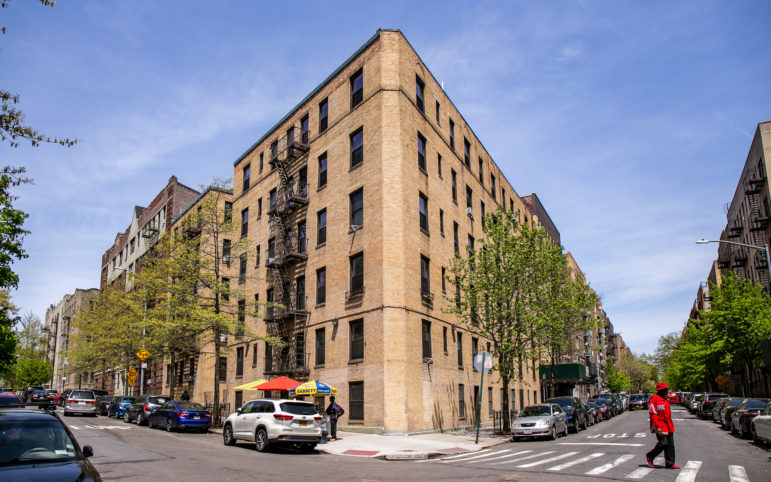“A better approach to tackling homelessness in New York City would be to just give unhoused New Yorkers housing.”

Adi Talwar
A Bronx residential building with rent-stabilized apartments on the corner of West Mosholu Parkway North and Knox Place.Move over COVID, and somebody please page Orthopedics. The latest epidemic is here, and symptoms include stiff neck, pain, loss of range of motion, and headache and tenderness at the base of the skull. If you’re suffering from whiplash, perhaps you got it keeping abreast of New York City’s plans for addressing homelessness over the past few years. Even worse, very little of what they’ve done has gotten it right.
Consider the first year of the COVID pandemic. The Department of Homeless Services (DHS) moved many unhoused New Yorkers from beds in communal shelters to single- and double-occupancy hotel rooms all over the city. These rooms, empty due to the halt in travel, were put to good use housing shelter residents aged 66 and older, as well as others with severe medical conditions and risk factors that made them vulnerable to serious COVID complications. This initiative was funded by Federal Emergency Management Agency (FEMA) funds promised until the end of 2020.
Despite the year of funding, the policy of using hotel rooms didn’t last, and hotel-dwellers found themselves uprooted to shelters (if they were unlucky) or to similar accommodations in distant boroughs when luck, or an appeal, came through. Though the hotel stays were always meant to be temporary, it shows poor planning that it only took three months before the first residents were being uprooted from their private rooms in the middle of a COVID surge, while the pandemic conditions remained just as dangerous.
Meanwhile, the city decided to pursue buying up empty hotels and turning them into permanent affordable housing and supportive housing options for unhoused people. Unfortunately, this plan has seen limited progress, and the consensus is that they missed the window of opportunity to purchase these properties. The rebound of tourism means that hoteliers are much less inclined to sell.
Transferring their attention from unhoused New Yorkers in the shelter system, city officials have also adopted policies for targeting those who are unhoused and living in the streets. For over a year, police, sanitation workers, and other city employees have been sweeping encampments of unhoused people, throwing out their belongings and attempting to coerce them into entering the shelter system. This hasn’t worked well. Further, Mayor Eric Adams has issued a directive encouraging NYPD to involuntarily hospitalize unhoused people who are mentally ill, including rolling out a hotline staffed by mental health professionals that officers can call for guidance.
What both of these policies get wrong is that they do nothing to address why some unhoused New Yorkers eschew the shelter system for the streets, like feeling unsafe in shelters, negative interactions with staff, and rigid rules and restrictions that make some shelters inhospitable and unwelcoming.
Some people can’t stay in shelters because they don’t meet requirements such as sobriety, forcing them to stay on the street until they are able to somehow conquer their substance use issues. The forced hospitalizations and encampment sweeps are also traumatic, and little success can be expected when approaching someone with services and resources in one hand while breaking up their informal communities, trashing their belongings, and arresting them with the other.
A better approach to tackling homelessness in New York City would be to just give unhoused New Yorkers housing. This approach is called Housing First, and the principle behind it is to provide housing much earlier in the timeline of services than is typical in other approaches, such as Continuum of Care or a Staircase model.
Those other approaches typically require that unhoused people with complex mental health needs or substance use issues complete treatment programs, or even achieve sobriety before being offered long-term housing options. Maybe they assume that, unresolved, these issues could jeopardize the housing. They probably assume that, with housing secured, the entities providing housing assistance could lose their leverage for incentivizing participation in things like treatment programs, jobs and skills training, and other services. There is probably some stigma involved, too; after all, do unhoused people deserve housing assistance if they are also using substances?
Yes, Housing First tells us. Yes, they absolutely do! For many reasons, but the most pragmatic one being that stable, dignified housing makes it easier for people to achieve their other goals, such as finding work, reuniting their families, accessing and adhering to medical treatment, accessing education, getting healthier, and even achieving and maintaining sobriety.
Those hotel rooms during COVID were, for a short time, a great intervention, well received by former shelter residents, and they had positive effects on their health and well-being that communal shelters were not able to provide. Small apartments, hotel rooms, assisted living apartment complexes, and group homes would all work and fit the needs of various families and individuals, and these housing options could also appeal to those who would prefer encampments to the conditions in a communal shelter.
COVID and Long COVID continue to take a disproportionate toll on the most socioeconomically vulnerable among us, unhoused New Yorkers on the street and in the shelter system included. Creating and distributing stable long-term housing through a Housing First approach could ultimately be the most important step the city takes in tackling the health and well-being of New York City’s unhoused population.
Iriane Narcisse is a first year student studying medicine and public health in New York City. She can be reached on Twitter @NarcisseIM.








